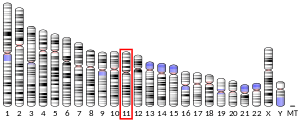FADS1
Fatty acid desaturase 1 is an enzyme that in humans is encoded by the FADS1 gene.[5]
Function
The protein encoded by the FADS1 gene is a member of the fatty acid desaturase (FADS) gene family and desaturates omega-3 and omega-6 polyunsaturated fatty acids at the delta-5 position, catalyzing the final step in the formation of eicosapentaenoic acid (EPA) and Arachidonic acid.[6] Desaturase enzymes (such as those encoded by FADS1) regulate unsaturation of fatty acids through the introduction of double bonds between defined carbons of the fatty acyl chain. FADS family members are considered fusion products composed of an N-terminal cytochrome b5-like domain and a C-terminal multiple membrane-spanning desaturase portion, both of which are characterized by conserved histidine motifs. This gene is clustered with family members FADS1 and FADS2 at 11q12-q13.1; this cluster is thought to have arisen evolutionarily from gene duplication based on its similar exon/intron organization.[5]
Clinical significance
Single nucleotide polymorphisms (SNPs) of FADS1 and FADS2 may affect long-chain polyunsaturated fatty acids (LC-PUFA) metabolism and have a potential role in the development of atopic diseases.[7]
References
- GRCh38: Ensembl release 89: ENSG00000149485 - Ensembl, May 2017
- GRCm38: Ensembl release 89: ENSMUSG00000010663 - Ensembl, May 2017
- "Human PubMed Reference:". National Center for Biotechnology Information, U.S. National Library of Medicine.
- "Mouse PubMed Reference:". National Center for Biotechnology Information, U.S. National Library of Medicine.
- "Entrez Gene: FADS1 fatty acid desaturase 1".
- Brenna, J Thomas (June 2009). "An alternate pathway to long-chain polyunsaturates: the FADS2 gene product Δ8-desaturates 20:2n-6 and 20:3n-3". Journal of Lipid Research. 50 (6): 1195–202. doi:10.1194/jlr.M800630-JLR200. PMC 2681401. PMID 19202133.
- Lattka, E.; Illig, T.; Heinrich, J.; Koletzko, B. (2009). "FADS Gene Cluster Polymorphisms: Important Modulators of Fatty Acid Levels and Their Impact on Atopic Diseases". Journal of Nutrigenetics and Nutrigenomics. 2 (3): 119–128. doi:10.1159/000235559. PMID 19776639.
Further reading
- Maruyama K, Sugano S (1994). "Oligo-capping: a simple method to replace the cap structure of eukaryotic mRNAs with oligoribonucleotides". Gene. 138 (1–2): 171–4. doi:10.1016/0378-1119(94)90802-8. PMID 8125298.
- Andersson B, Wentland MA, Ricafrente JY, et al. (1996). "A "double adaptor" method for improved shotgun library construction". Anal. Biochem. 236 (1): 107–13. doi:10.1006/abio.1996.0138. PMID 8619474.
- Suzuki Y, Yoshitomo-Nakagawa K, Maruyama K, et al. (1997). "Construction and characterization of a full length-enriched and a 5'-end-enriched cDNA library". Gene. 200 (1–2): 149–56. doi:10.1016/S0378-1119(97)00411-3. PMID 9373149.
- Stöhr H, Marquardt A, Rivera A, et al. (1998). "A Gene Map of the Best's Vitelliform Macular Dystrophy Region in Chromosome 11q12–q13.1". Genome Res. 8 (1): 48–56. doi:10.1101/gr.8.1.48. PMC 310689. PMID 9445487.
- Cho HP, Nakamura M, Clarke SD (2000). "Cloning, expression, and fatty acid regulation of the human delta-5 desaturase". J. Biol. Chem. 274 (52): 37335–9. doi:10.1074/jbc.274.52.37335. PMID 10601301.
- Leonard AE, Kelder B, Bobik EG, et al. (2000). "cDNA cloning and characterization of human Delta5-desaturase involved in the biosynthesis of arachidonic acid". Biochem. J. 347 Pt 3 (3): 719–24. doi:10.1042/0264-6021:3470719. PMC 1221008. PMID 10769175.
- Marquardt A, Stöhr H, White K, Weber BH (2000). "cDNA cloning, genomic structure, and chromosomal localization of three members of the human fatty acid desaturase family". Genomics. 66 (2): 175–83. doi:10.1006/geno.2000.6196. PMID 10860662.
- Brizio C, Galluccio M, Wait R, et al. (2006). "Over-expression in Escherichia coli and characterization of two recombinant isoforms of human FAD synthetase". Biochem. Biophys. Res. Commun. 344 (3): 1008–16. doi:10.1016/j.bbrc.2006.04.003. PMID 16643857.
- Schaeffer L, Gohlke H, Müller M, et al. (2006). "Common genetic variants of the FADS1 FADS2 gene cluster and their reconstructed haplotypes are associated with the fatty acid composition in phospholipids". Hum. Mol. Genet. 15 (11): 1745–56. doi:10.1093/hmg/ddl117. PMID 16670158.
- Ma J, Dempsey AA, Stamatiou D, et al. (2007). "Identifying leukocyte gene expression patterns associated with plasma lipid levels in human subjects". Atherosclerosis. 191 (1): 63–72. doi:10.1016/j.atherosclerosis.2006.05.032. PMID 16806233.
- Dreesen TD, Adamson AW, Tekle M, et al. (2006). "A newly discovered member of the fatty acid desaturase gene family: a non-coding, antisense RNA gene to delta5-desaturase". Prostaglandins Leukot. Essent. Fatty Acids. 75 (2): 97–106. doi:10.1016/j.plefa.2006.05.001. PMID 16846730.
- Ewing RM, Chu P, Elisma F, et al. (2007). "Large-scale mapping of human protein–protein interactions by mass spectrometry". Mol. Syst. Biol. 3 (1): 89. doi:10.1038/msb4100134. PMC 1847948. PMID 17353931.
- Risé P, Ghezzi S, Carissimi R, et al. (2007). "Delta5 desaturase mRNA levels are increased by simvastatin via SREBP-1 at early stages, not via PPARalpha, in THP-1 cells". Eur. J. Pharmacol. 571 (2–3): 97–105. doi:10.1016/j.ejphar.2007.06.021. PMID 17655842.



